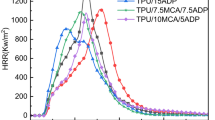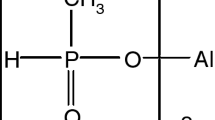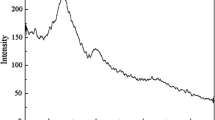Abstract
In this paper, 1-aminoethyl-3-methylimidazolium hexafluorophosphate ([APMIm]PF6) and 1-butyl-3-methylimidazolium hexafluorophosphate ([EMIM]PF6) were used as flame retardant additives in thermoplastic polyurethane elastomer (TPU). The flame retardant effect of [APMIm]PF6 and [EMIM]PF6 in TPU had been investigated by cone calorimeter (CCT), scanning electron microscope (SEM), energy-dispersive spectroscopy (EDS), microcombustion calorimeter (MCC), fourier transform infrared spectroscopy (FT-IR), smoke density test (SDT), thermogravimetric analysis (TG) and thermogravimetric/fourier transform infared spectroscopy (TG-IR), respectively. The results indicated that TPU/[APMIm]PF6 had better thermal properties compared with pure TPU and TPU/[EMIM]PF6. The peak heat release rate (pHRR) of TPU/A-1.0 was remarkably reduced by 32.97% and 19.15%, in comparison with that of TPU and TPU/E-1.0. Moreover, the total heat release (THR) and smoke production rate (SPR) of TPU/A-1.0 were the lowest among all samples. And, in the early stage of fire, [APMIm]PF6 can promote the formation of protective carbon layer, reduce the HRR and SPR. Therefore, it is necessary to develop environment-friendly green flame retardants.










Similar content being viewed by others

References
Tabuani D, Bellucci F, Terenzi A, Camino G. Flame retarded thermoplastic polyurethane (TPU) for cable jacketing application. Polym Degrad Stab. 2012;97(12):2594–601.
Wang J, Ma C, Mu X, Cai W, Liu L, Zhou X, et al. Construction of multifunctional MoSe2 hybrid towards the simultaneous improvements in fire safety and mechanical property of polymer. J Hazard Mater. 2018;352:36–46.
Chen X, Feng X, Jiao C. Combustion and thermal degradation properties of flame-retardant TPU based on EMIMPF6. J Therm Anal Calorim. 2017;129(2):851–7.
Alshabanat M, Al-Anazy M. Effect of cationic-surfactant-modified Saudi bentonite on the thermal and flammability properties of poly(vinyl alcohol)-based nanocomposite films. J Taibah Univ Sci. 2019;13(1):360–9.
Dasari A, Yu Z-Z, Cai G-P, Mai Y-W. Recent developments in the fire retardancy of polymeric materials. Prog Polym Sci. 2013;38(9):1357–87.
Zhang M, Buekens A, Li X. Brominated flame retardants and the formation of dioxins and furans in fires and combustion. J Hazard Mater. 2016;304:26–39.
Tirri T, Aubert M, Aziz H, Brusentsev Y, Pawelec W, Wilén C-E. Sulfenamides in synergistic combination with halogen free flame retardants in polypropylene. Polym Degrad Stab. 2019;164:75–89.
Amarnath N, Appavoo D, Lochab B. eco-friendly halogen-free flame retardant cardanol polyphosphazene polybenzoxazine networks. ACS Sustain Chem Eng. 2017;6(1):389–402.
Huang G, Chen S, Song P, Lu P, Wu C, Liang H. Combination effects of graphene and layered double hydroxides on intumescent flame-retardant poly(methyl methacrylate) nanocomposites. Appl Clay Sci. 2014;88–89:78–85.
Salmeia KA, Gooneie A, Simonetti P, Nazir R, Kaiser J-P, Rippl A, et al. Comprehensive study on flame retardant polyesters from phosphorus additives. Polym Degrad Stab. 2018;155:22–34.
Hobbs CE. Recent advances in bio-based flame retardant additives for synthetic polymeric materials. Polymers. 2019;11(2):224.
Guo Q, Cao J, Han Y, Tang Y, Zhang X, Lu C. Biological phytic acid as a multifunctional curing agent for elastomers: towards skin-touchable and flame retardant electronic sensors. Green Chem. 2017;19(14):3418–27.
Jiao C, Jiang H, Chen X. Properties of fire agent integrated with molecular sieve and tetrafluoroborate ionic liquid in thermoplastic polyurethane elastomer. Polym Adv Technol. 2019;30(8):2159–67.
Jiao C, Wang H, Chen X, Tang G. Flame retardant and thermal degradation properties of flame retardant thermoplastic polyurethane based on HGM@[EOOEMIm][BF4]. J Therm Anal Calorim. 2018;135(6):3141–52.
Jiang H-C, Lin W-C, Hua M, Pan X-H, Shu C-M, Jiang J-C. Difunctional effects of [Bmim][DBP] on curing process and flame retardancy of epoxy resin. J Therm Anal Calorim. 2019;137(5):1707–17.
Chen X, Wang W, Li S, Jiao C. Fire safety improvement of para-aramid fiber in thermoplastic polyurethane elastomer. J Hazard Mater. 2017;324(Pt B):789–96.
Chen X, Jiao C. Synergistic effects of hydroxy silicone oil on intumescent flame retardant polypropylene system. Fire Saf J. 2009;44(8):1010–4.
Dogan M. Thermal stability and flame retardancy of guanidinium and imidazolium borate finished cotton fabrics. J Therm Anal Calorim. 2014;118(1):93–8.
Fu S-Q, Guo J-W, Zhu D-Y, Yang Z, Yang C-F, Xian J-X, et al. Novel halogen-free flame retardants based on adamantane for polycarbonate. RSC Adv. 2015;5(82):67054–65.
Teixeira M, Sonnier R, Otazaghine B, Ferry L, Aubert M, Tirri T, et al. Radiation-grafting of flame retardants on flax fabrics—a comparison between different flame retardant structures. Radiat Phys Chem. 2018;145:135–42.
Hoang D, Pham T, Nguyen T, An H, Kim J. Organo-phosphorus flame retardants for poly(vinyl chloride)/wood flour composite. Polym Compos. 2018;39(3):961–70.
Qiu S, Ma C, Wang X, Zhou X, Feng X, Yuen RKK, et al. Melamine-containing polyphosphazene wrapped ammonium polyphosphate: a novel multifunctional organic-inorganic hybrid flame retardant. J Hazard Mater. 2018;344:839–48.
Yu B, Tawiah B, Wang LQ, Yin Yuen AC, Zhang ZC, Shen LL, et al. Interface decoration of exfoliated MXene ultra-thin nanosheets for fire and smoke suppressions of thermoplastic polyurethane elastomer. J Hazard Mater. 2019;374:110–9.
Ai L, Chen S, Zeng J, Yang L, Liu P. Synergistic flame retardant effect of an intumescent flame retardant containing boron and magnesium hydroxide. ACS Omega. 2019;4(2):3314–21.
Shi Y, Yu B, Zhou K, Yuen RK, Gui Z, Hu Y, et al. Novel CuCo2O4/graphitic carbon nitride nanohybrids: highly effective catalysts for reducing CO generation and fire hazards of thermoplastic polyurethane nanocomposites. J Hazard Mater. 2015;293:87–96.
Wang S, Gao R, Zhou K. The influence of cerium dioxide functionalized reduced graphene oxide on reducing fire hazards of thermoplastic polyurethane nanocomposites. J Colloid Interface Sci. 2019;536:127–34.
Zhou K, Liu C, Gao R. Polyaniline A novel bridge to reduce the fire hazards of epoxy composites. Composites A. 2018;112:432–43.
Zhao S, Yin J, Zhou K, Cheng Y, Yu B. In situ fabrication of molybdenum disulfide based nanohybrids for reducing fire hazards of epoxy. Composites A. 2019;122:77–84.
Li H, Ning N, Zhang L, Wang Y, Liang W, Tian M. Different flame retardancy effects and mechanisms of aluminium phosphinate in PPO, TPU and PP. Polym Degrad Stab. 2014;105:86–95.
Yang H, Jiang Y, Liu H, Xie D, Wan C, Pan H, et al. Mechanical, thermal and fire performance of an inorganic-organic insulation material composed of hollow glass microspheres and phenolic resin. J Colloid Interface Sci. 2018;530:163–70.
Zhou K, Gao R, Qian X. Self-assembly of exfoliated molybdenum disulfide (MoS2) nanosheets and layered double hydroxide (LDH) towards reducing fire hazards of epoxy. J Hazard Mater. 2017;338:343–55.
Chen X, Zhang X, Wang W, Wang Y, Jiao C. Fire-safe agent integrated with oyster shell and melamine polyphosphate for thermoplastic polyurethane. Polym Adv Technol. 2019;30(7):1576–88.
Yuan B, Hu Y, Chen X, Shi Y, Niu Y, Zhang Y, et al. Dual modification of graphene by polymeric flame retardant and Ni(OH) 2 nanosheets for improving flame retardancy of polypropylene. Composites A. 2017;100:106–17.
Zhou K, Tang G, Gao R, Jiang S. In situ growth of 0D silica nanospheres on 2D molybdenum disulfide nanosheets towards reducing fire hazards of epoxy resin. J Hazard Mater. 2018;344:1078–89.
Wu N, Fu G, Yang Y, Xia M, Yun H, Wang Q. Fire safety enhancement of a highly efficient flame retardant poly(phenylphosphoryl phenylenediamine) in biodegradable poly(lactic acid). J Hazard Mater. 2019;363:1–9.
Lin D, Zeng X, Li H, Lai X, Wu T. One-pot fabrication of superhydrophobic and flame-retardant coatings on cotton fabrics via sol-gel reaction. J Colloid Interface Sci. 2019;533:198–206.
Jiao C, Jiang H, Chen X. Reutilization of abandoned molecular sieve as flame retardant and smoke suppressant for thermoplastic polyurethane elastomer. J Therm Anal Calorim. 2019;138(6):3905–13.
Acknowledgements
The authors gratefully acknowledge the National Natural Science Foundation of China (No. 51776101), the Natural Science Foundation of Shandong Province (ZR2017MB016), and the Project of the State Administration of Work Safety (Shandong-0039-2017AQ).
Author information
Authors and Affiliations
Corresponding author
Additional information
Publisher's Note
Springer Nature remains neutral with regard to jurisdictional claims in published maps and institutional affiliations.
Rights and permissions
About this article
Cite this article
Jiao, C., Zhang, Y., Li, S. et al. Flame retardant effect of 1-aminoethyl-3-methylimidazolium hexafluorophosphate in thermoplastic polyurethane elastomer. J Therm Anal Calorim 145, 173–184 (2021). https://doi.org/10.1007/s10973-020-09671-2
Received:
Accepted:
Published:
Issue Date:
DOI: https://doi.org/10.1007/s10973-020-09671-2



